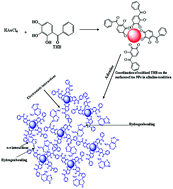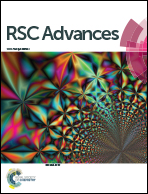2,3,4-Trihydroxy benzophenone as a novel reducing agent for one-step synthesis of size-optimized gold nanoparticles and their application in colorimetric sensing of adenine at nanomolar concentration†
Abstract
In this work, we report the use of 2,3,4-trihydroxy benzophenone (THB) as a novel reducing and stabilizing agent for the one-step synthesis of size-optimized gold nanoparticles (Au NPs). We have optimized various parameters such as reducing agent concentration, time and temperature for the controlling of Au NPs size and surface plasmon resonance (SPR) peak. The size and morphology of THB-Au NPs were confirmed by transmission electron microscopy (TEM) and dynamic light scattering (DLS) techniques. The average hydrodynamic diameter of THB-Au NPs was found to be ∼12 nm. The absorption ratio at A658/A525 for THB-Au NPs could be correlated quantitatively with the concentrations of adenine in the range of 0.005–100 μM. The detection limit of adenine was estimated to be as low as 1.4 nM based on the absorbance measurements of THB induced aggregated Au NPs at 658 nm. In addition, this probe was successfully applied to detect adenine in biological samples such as urine and serum samples with reduced sample volumes.


 Please wait while we load your content...
Please wait while we load your content...